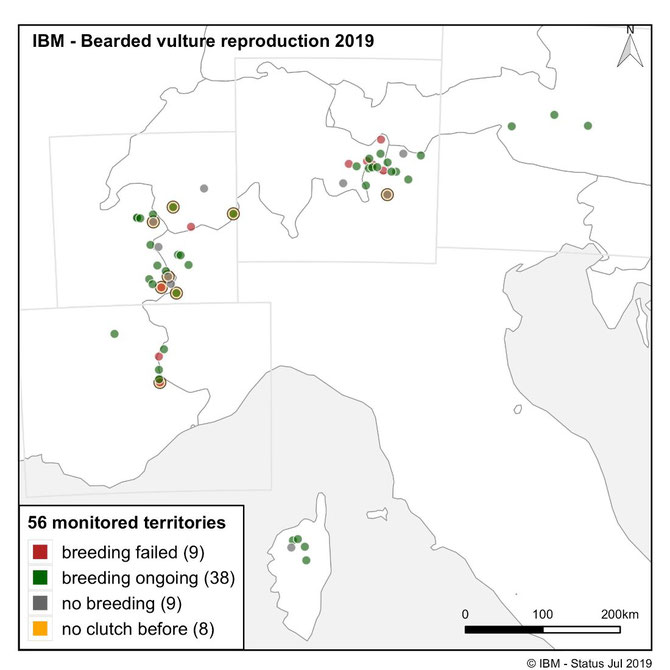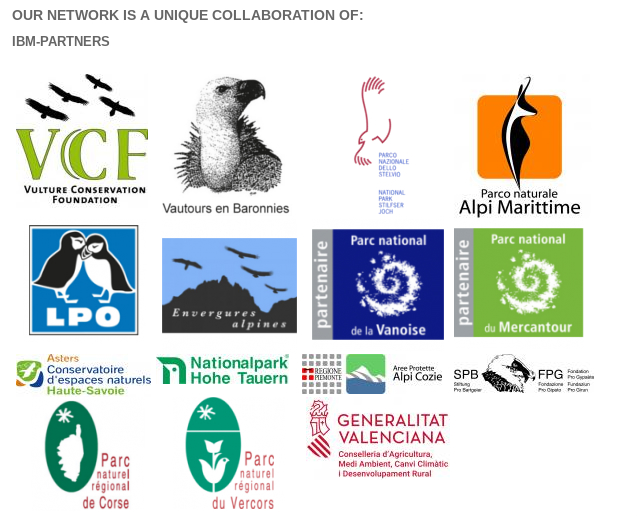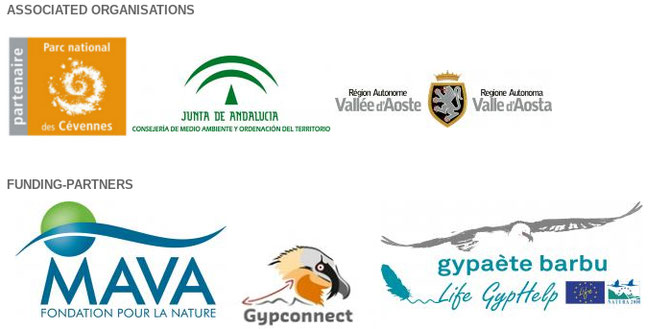
Bearded Vultures are very busy during this year’s breeding season! The monitoring of their breeding populations in the Alpine range and on Corsica is coordinated by the International Bearded Vulture Monitoring Network (IBM). The breeding situation is regularly updated and reported to the IBM-database. So, how many breeding pairs, incubating clutches and fledglings have we observed up until now?
Latest reports of breeding

In this year’s breeding season 56 occupied territories, with 52 breeding pairs and four breeding trios, are monitored in the Alps and on Corsica. Out of these, a clutch has been observed in 47 nests with 37 chicks hatching. We were lucky to see eight fledglings already taking off for their first flights, and we are looking forward to receiving positive news from the remaining 26 hatchlings. Across all territories, nine breeding failures have already been reported.
How are the birds observed and identified?
Between the 1st of April 2019 and the 30th of June 2019, the IBM database received a total of 272 Bearded Vulture observations, in 112 cases the birds could even be identified on the individual level. There are different methods of identifying and monitoring wildlife, and in this case, the most common identifications were possible thanks to individual features, rings, GPS-data and bleached feathers (in this order).
Breeding success in the south-western Alps
Great news from the south-western Alps: In four out of six territories, our partners reported the hatch of a young chick and one of them already fledged. We hope that the other chicks survive and will fledge in the next few months.
Fascinating breeding facts
Bearded Vultures are most commonly monogamous, and breed once a year. The birds usually don’t lay more than two eggs, and even if they do, only one survives due ‘obligatory cainism’. This is an evolutionary response in a situation where there is relatively little food. Bearded Vulture chicks display aggressive behaviour while they are in the nest, which results in the death of the younger sibling when there are two hatchlings. This behaviour is present during the whole nestling period, and so it is impossible to raise two chicks together in the same nest.
Sometimes, especially in some regions of Spain and France, bachelor Bearded Vultures will join a pre-existing couple to create a polyandrous trio. Females accept secondary mates because it increases the chances of producing offspring and doubles their protection.
The International Bearded Vulture Monitoring Network

The International Bearded Vulture Monitoring Network (IBM) is a unique international collaboration led by the Vulture Conservation Foundation between national & natural parks and non-governmental organisations to coordinate the monitoring activities for European Bearded Vulture populations. Through this network, data about the Bearded Vulture in Europe is collected, shared and made available to everyone working for the conservation of the species. The IBM-network also uses this data and comes together to discuss conservation strategies and priorities for this species on an international level. There are currently 15 partners and three associated organisations part of the IBM-network.






